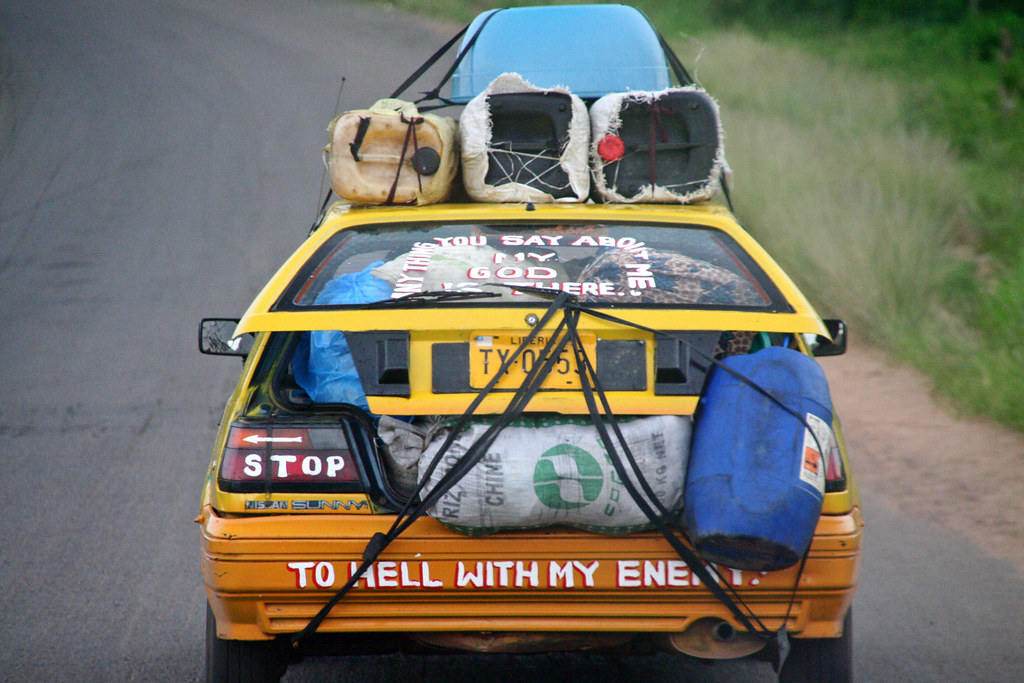The rains are getting worse.
I ventured out to downtown Water Street with fellow crewmember Megan today. Although overcast, the weather was great. A slight breeze ruffled our hair as we clomped down the gangway in our flip flops and made our way to the main gate. Before I left my cabin, I briefly debated bringing my umbrella. However, a misadventure last weekend had left a small explosion of SPF 50 sunscreen all over it, and so I decided to leave it behind.
It started out as a relatively lucky transportation day. As we walked out of the main gate we started making a lateral chopping motion with our hands (the only proper way to hail a Liberian taxi). After about 5 minutes we were in a run-down yellow cab crammed with 6 other people, on our way into downtown Monrovia. At Broad Street, our driver turned to us and told us we had to switch cabs, to another one going to Sinkor. And so we hopped out and started to search. Buses and taxis passed us by, all too full or too busy going somewhere else. Finally, a guy driving a Cellcom service van stopped and we hopped in, on our way to Sinkor.
We had a quick lunch in Sinkor, and then tried to find another taxi. Again, an unfruitful expedition. Finally, we were picked up by a well-meaning Lebanese contractor, who gave us a ride back to downtown Monrovia.
Hitchhiking has never been my thing. However, in Monrovia, with NGO and UN workers totaling over 10,000, it is often a better bet to get a ride in one of their vehicles than to take your chances with a yellow cab. Yellow cabs here are often crammed 7 people to a car (2 in the front passenger seat and 4 in the back, plus a driver), have cracked windshields, and lack door or window handles. These Nissans and Sunnys are the most prevalent vehicles on the road, and are often plastered with slogans like "City Boy" or "God's Choice." Or worse.
Water Street is known for its fabric shops. The larger, more prosperous shops are Lebanese-owned, with proprietors who travel as far as Dubai where there is a large fabric exchange. Cloth vendors converge from all over the world to hawk their wares, and these fabric shops sell anything from cotton prints and tie-dyes to fine Japanese lace and velvet leopard print. Smaller shops usually line back alleys, and are more wooden shacks with plastic tarp than anything else. Finally individual women and boys carry lappas (one lappa is 2 yards) bundled together in plastic tubs and perched on their heads. These vendors usually sell only African prints, which are always a swirl of color, and on closer examination reveal a repeating motif—chickens, crustaceans, giant tubes of lipstick, or tree stumps.
We were happily browsing on Water Street when the skies opened up. The erstwhile roads and sidewalks quickly became a mess of trash, mud, sewage, and water. With no drains and a fierce tropical storm, we were quickly left knee deep in filth. As we debated how to reach higher ground, the local Liberians, huddled underneath awnings, started to shout things like "Roll up your pants!" and "This is Africa!." That's when Megan turned to me and asked, "Can we pull a Moses?"
09 May 2008
Can we pull a Moses?
Posted by
Peggy
at
5/09/2008 03:03:00 PM
![]()
Subscribe to:
Post Comments (Atom)





No comments:
Post a Comment